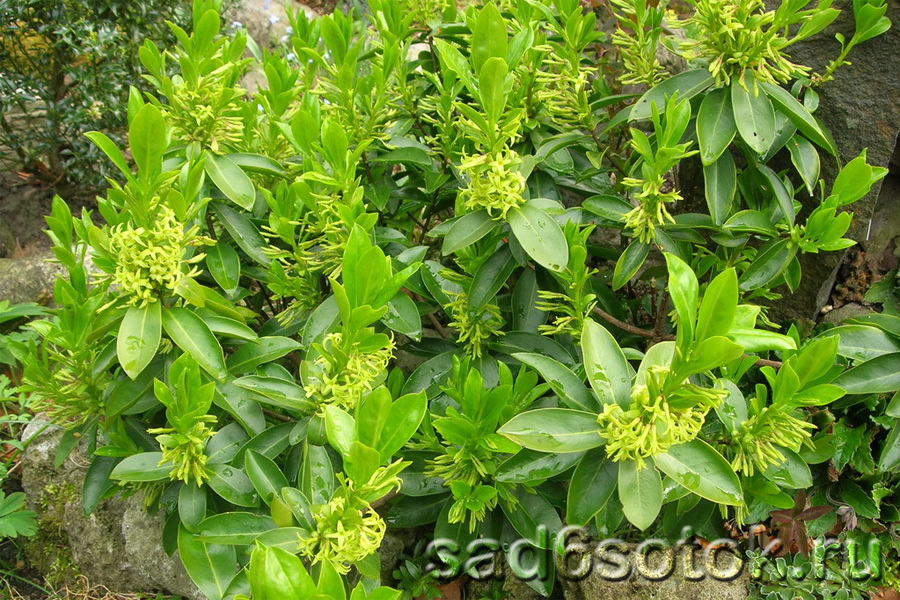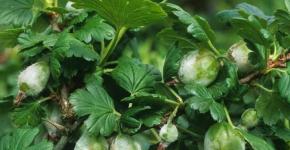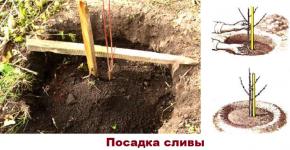Daphne - types, care
Daphne (Daphne) - popular types, features of care
These spectacular plants look great in the form of individual specimens or in groups, they are good against the background of a lawn, shrub plantations. But like most beauties, they are very cunning ...
The scientific name is given by the name of the nymph Daphne, the heroine of the ancient Greek myth. Apollo was inflamed with passion for the beautiful nymph, but she rushed away in fright. God chased after her, and the fugitive, realizing that she could not be saved, prayed to the goddess of the earth Gaia, asking for help. Gaia heeded the request and turned the nymph into a slender laurel tree ( daphne in Greek means "Laurel"). The Russian name reflects the poisonous properties of these plants, their danger. The most common species of the genus in Russia is deadly wolf (D. mezereum), called a wolf bast.
Showy shrubs
All daphne are deciduous or evergreen shrubs. They differ in miniature size, not exceeding 1–3 m in height, and some alpine species rise only a few centimeters above the ground. The leaves of wolfberry are solid, long, narrow or elliptical. Daphne blooms in late winter - early spring. The flowers are small, but numerous, densely cover the shoots of the previous year or are collected in dense caps on the tops of the stems. The petals are colored pink, lilac, greenish-yellow, and may be white.
Blooming wolfberries delight not only the eyes, their flowers emit a strong and very pleasant aroma, which differs in different species.
Flowering is quite long, from two to three weeks, and in cold weather - up to a month.
Attractive fruits
In the first half of summer, daphne attracts only with foliage unusual for our latitudes, which evokes thoughts of the flora of a warmer climate. But at the end of July and August, wolfberries again attract the eye with fruits of bright red, yellow or black color.
Unfortunately, in central Russia, fruit ripening can only be expected from wolf bast, but its bushes are fabulously good in autumn. Long narrow leaves acquire a pale yellow color, and between them on branches numerous large red or yellow (in the white-flowered form of Alba) shiny berries sit. They persist for a long time on the branches after the leaves fall, such bushes look great in the autumn garden against the background of dark conifers, fallen leaves, first snow.
Different-beautiful
In European ornamental gardening, many types of daphne are used, some of which are too thermophilic for Russian conditions. However, wolfberries such as alpine (D. alpina) and branched (D. arbuscula), may well decorate our gardens. Of the species common on the territory of Russia and, accordingly, more suitable for culture in harsh conditions, wolfberry can be called fatal (D. mezereum), Altai (D. altaica), Caucasian (D. caucasica), Julia (D. julia), pontic (D. pontica).
Meet the wolf bast
The most unpretentious in culture has established itself deadly wolfberry, or wolf bast (D. mezereum)... In nature, this species is found in forest areas in the north and in the middle zone of European Russia, in Western Siberia, in the Caucasus, in Western Europe. The plant got its name for its strong bark, which is very difficult to break. If you try to pick a flowering twig, never bring your fingers to your mouth or eyes afterwards without first washing them.

The wolf's bast is perfectly adapted to the harsh growing conditions, therefore it is unpretentious in culture. This type of daphne is frost-hardy, does not require shelter for the winter, and prefers partial shade in the garden. It responds well to the introduction of peat into the soil. Flowering occurs very early, before the leaves open, usually begins in early to mid-April. The lilac four-petal flowers that densely cover the shoots of last year are very reminiscent of lilacs, but the strong smell has nothing to do with the scent of the messenger of summer. Most of all, it resembles a bright, refined smell of wax inflorescences of two-leaved Lyubka.
Genus Wolfberry, or Wolf (Daphne), from the family Wolfberry (Thymelaeaceae) has about 50 species distributed in Europe, Asia and North Africa. Carl Linnaeus, giving scientific names to the plants, christened daphne daphne, possibly because the leaves of some evergreen species of daphne look like laurel leaves.
Blooming wolf is not afraid of spring frosts and snowfalls and is very valuable for early flowering periods. In central Russia, only hazel can compete with him in this regard.
Miniature tree
In nature, the deadly wolf usually looks like small bushes with weak twigs. After being transferred to the garden, in a couple of years it turns into a neat miniature tree with a thick trunk and a rounded crown. Its height does not exceed a little over a meter. After flowering, last year's wolf bast shoots are covered with dense narrow leaves up to 10 cm long. In August, beautiful bright red shiny berries ripen, sitting on twigs in the manner of sea buckthorn berries.
Cultural varieties

Currently, in addition to the natural white-flowered form, there are the following cultural varieties of wolf bast.Large-flowered form (f. Grandiflora)with larger, than the natural species, bright purple flowers,terry (f. Plena)with white double flowers,variety "Bowles Variety"- plant up to 2 m tall with pure white flowers and yellow fruits,grade "Rubra Select"with large reddish flowers,variety "Variegata"with white-bordered leaves.
While admiring the bright fruits, remember that the wolfberries got their name for a reason - most species, including the wolf's bast, are very poisonous. All parts of the plant are dangerous: bark, leaves, flowers, fruits. 10-15 berries contain a dose of poison that is fatal to humans, so if children visit the garden, it is better to cut off the fruits.
Altai wolfberry

In nature, it is found mainly in the Western Altai. It is a deciduous shrub 0.5–1.5 m tall, often looking like a miniature tree with a strong stem. The leaves are elongated, the flowers are white, collected at the ends of the branches in capitate inflorescences. It blooms profusely in May-June, after the leaves have opened or at the same time. The fruits are bright red, brownish black or black. Weak re-flowering often occurs in September-October. Photophilous, winter-hardy.
Pontic wolfberry

Originally from the Western Ciscaucasia. In the garden, he prefers fresh fertile soil and open spaces. Evergreen shrub 1–1.5 m tall. The leaves are large (up to 10 cm long), oval, dark green, shiny. Flowering occurs in early summer. The flowers are yellow-green, fragrant, rather large for daphne (about 2 cm in diameter), collected in the leaf axils. The fruits are juicy black berries. Although it winters well in central Russia, it blooms irregularly and does not set fruit.
Care features
Daphne is unpretentious. They require the most common care: weeding, watering in dry weather. It is useful to fertilize with complex mineral fertilizer in the spring and add nutritious compost under the bush in the fall. Deadly wolfberry is extremely frost-hardy.
The ability of other daphnids to endure winter in central Russia depends on the conditions of their natural habitats. Some species may require cover. Weak and damaged shoots due to early flowering are usually removed in the fall. A haircut is not recommended, because wolfberries grow slowly and they themselves perfectly form a crown, which persists for many years.
Many daphns are shade-tolerant, but the best results in culture can be achieved in partial shade or even sunny areas. Full lighting is especially important for alpine views such as alpine wolf, Julia.
Soils prefer nutritious, light, moist, but well-drained. They do not tolerate prolonged overdrying.
Daphne is useful to mulch tree trunks, since their root system is shallow and easily damaged even when weeding.
Wolf wolves are resistant to pests and diseases, although occasionally they are affected by some viral diseases and gray rot. Of the pests, aphids can be the most dangerous.


